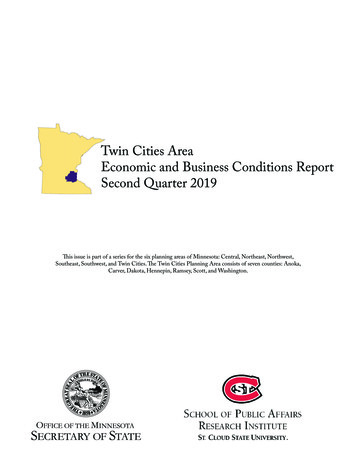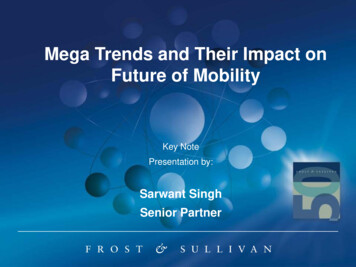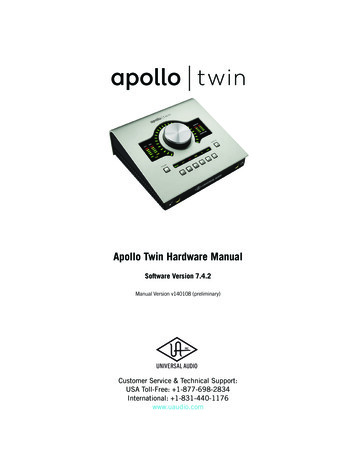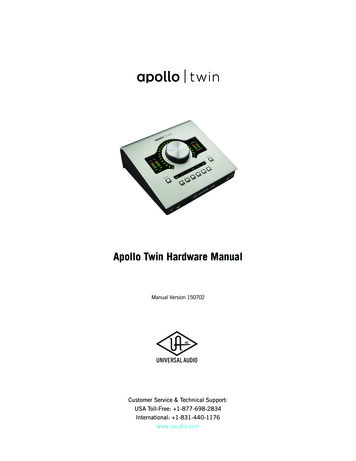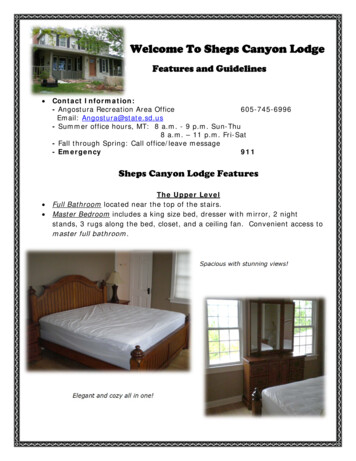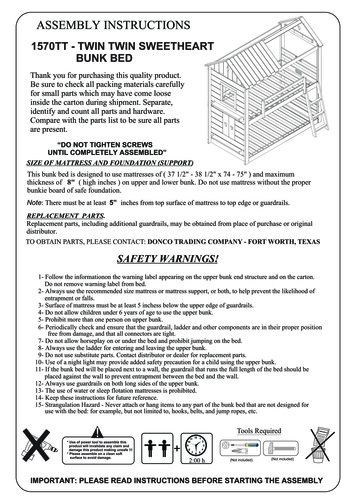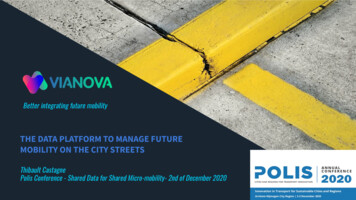
Transcription
TWIN CITIESSHARED MOBILIT Y ACTION PLAN
TABLE OF CONTENTSI. IntroductionII. Background and Existing ConditionsGrowth Projections and Equity ImplicationsOverview of Shared Mobility by ModePublic tion Demand ManagementTaxisIII. Opportunity AnalysisRegional OpportunityFocus Areas and Division of ApproachIV. Plan GoalsOther Metrics for SuccessV. Recommended Strategies1. Grow Shared Mobility in Support of the Transit Network2. Pilot Flexible Transit that Focuses on Reverse Commute Challenges3. Leverage the Metro Transit App to Establish a Data Clearinghouse4. Stabilize and Grow Carsharing5. Expand and Evolve Bikesharing6. Elevate Vanpooling as a Viable Option for Commuters7. Develop and Implement New Carpooling and Ride-Splitting Solutions8. Concentrate Efforts around Integrated Mobility Hubs9. Realign CMAQ Funding and Improve TDM Outcomes10. Optimize Parking and Street Space to Prioritize Shared MobilityVI. Implementation ProcessFunding SourcesImplementation ScheduleRoles of Project PartnersEvolving Role of Twin Cities Stakeholder Organizations in Shared MobilityVII. ConclusionAppendix A: Metropolitan Council Community DesignationsAppendix B: Transit Market AreasAppendix C: Planning Efforts to DateAppendix D: Comparison with Peer CitiesAppendix E: CMAQ Details and TDM Best 3032343536373839414344454748
AcknowledgementsThe Shared-Use Mobility Center (SUMC) is grateful to The McKnight Foundation, and Eric Muschler in particular, whosesupport made this plan possible. Jessica Treat from Smart Trips/Transit for Livable Communities (ST/TLC), Bill Dossettfrom Nice Ride Minnesota, and Jon Wertjes from the City of Minneapolis also were critical champions who originallyidentified the need for a regional dialogue on shared mobility, introduced the research team to key communitystakeholders, and provided a sounding board for the findings featured in this report.SUMC is also grateful to the many Twin Cities organizations and individuals—in the public, private, and nonprofitsectors—who took the time to help inform the research team’s understanding of the region’s unique transportation andjurisdictional landscape. Discussions with a number of local government stakeholders, particularly those taking partin the Smart Cities Challenge working group, provided a window into the public sector’s interest in shared mobility.Metropolitan Council members, elected officials, and agency staff at Metro Transit, the cities of Minneapolis and St.Paul, and Hennepin and Ramsey Counties also shared important insights about the potential for new transportationsolutions in the region.The Twin Cities benefit from a robust set of nonprofit and community-based champions for public transit, activetransportation, social equity, and economic development. Contributions from staff and board members of ST/TLC,Hourcar, East Metro Strong, Nice Ride Minnesota, Move Minneapolis, and the University of Minnesota also helped toinform this report.This plan was authored by SUMC’s Creighton Randall, with support from Aaron Westling and Colin Murphy, and editedby Tim Frisbie. SUMC Executive Director Sharon Feigon guided this project and provided overall direction for the plan.Designed by Jacob Karasik. 2017 Shared-Use Mobility Center. All Rights Reserved.“Downtown Minneapolis” by M01229. https://flic.kr/p/cUG4MA. Licensed by CC BY 2.0
PA RT IINTRODUCTIONPhoto: “Transit oriented development near the Raymond Avenue Station on the METRO Green Line”by Eric Wheeler, Metro Transit. Licensed under CC BY 2.0. https://flic.kr/p/orTK84The Minneapolis-St. Paul region is expected to gain more than 800,000 new residents by 2040, outpacing the growthrates of larger metropolitan areas such as Los Angeles, Boston and New York City. This expansion will have manysignificant impacts for the Twin Cities—including on the region’s transportation network.At current household vehicle ownership rates, this level of growth could add more than 675,000 personal vehicles tothe road, leading to increased traffic congestion, greater CO2 emissions, and reductions in productivity and quality oflife. Meanwhile, residents who don’t have access to reliable transportation options will continue to be isolated fromjobs, opportunity and vital community resources.In recent years, the region has made notable improvements to its public transit system, including launching bus rapidtransit service and building a new Green Line light rail route that helped to “re-twin” the Twin Cities. It was also anearly pioneer in bikesharing, carsharing and other forms of shared mobility. However, it has lost some ground lately,while peer cities such as Seattle and Denver have been scaling shared mobility and transit on a remarkable level—andattracting millennials who are less interested in owning cars than previous generations and more inclined to seek outwalkable, amenity-rich urban environmentsFor the Twin Cities to compete for the jobs, workers and economic opportunities of tomorrow—and expand affordable,environmentally sound transportation options for all—the region must invest in innovative solutions, pursue new policiesand claim its position as a national leader in shared mobility.To be successful, Twin Cities leaders must break down silos and work in a comprehensive manner to transform theregion’s transportation system. The public right of way is managed by a complex web of local, county, regional and stategovernments with varied and sometimes overlapping responsibilities, which will make efforts to coordinate this work3
difficult but critical. These leaders must also work together to address several deep-seated transportation challenges,including: Disparities in transportation access. Much of the region—urban, suburban, and rural—has not seen thebenefit of recent transit investments. As public transportation evolves, the imperative must be to foster thegrowth of effective transit service with a focus on social and geographic equity. New shared mobility modelscan support this goal. The stagnation of shared mobility services. National one-way carshare operator car2go left the TwinCities market in December 2016. Long-standing operators Hourcar and Zipcar have seen little growth inrecent years. Meanwhile Metro Vanpool participation has also levelled off since launching in 2000, andinnovative new forms of ride-splitting and microtransit have not yet launched in the region. Overall, theseservices need stronger policy and programmatic support to fulfill their promise and serve a broader range ofneighborhoods. The ease of driving and parking. Currently, many residents don’t feel compelled to consider othertransportation options. Congestion is becoming a growing concern and will get worse as the region’spopulation grows, unless there is a significant change in the way people get around. Owning and operating acar is also expensive, and as a result transportation is the second biggest cost for most families after housing.It has also become the largest source of carbon emissions in the U.S. To increase access to affordable,sustainable forms of transportation, more must be done to reduce reliance on private autos.With support from The McKnight Foundation, the Shared-Use Mobility Center (SUMC) has created this Shared MobilityAction Plan for the Twin Cities to help local leaders address these challenges, realize emerging opportunities, andestablish a new vision for the region. Based on information gleaned from interviews with more than 75 stakeholders,findings from a series of regional shared mobility workshops, and research on best practices, this action plan isdesigned to help improve regional mobility through a series of recommended policy, programming, and fundingstrategies.At the core of the plan is a mode shift goal that recommends taking advantage of rapidly changing travel behaviors,demand, and technology to remove 50,000 private cars from the road in the Twin Cities over the next 10 years, andthereby help to maintain the region’s livability, affordability and freedom of movement. The plan also features a firstof-its-kind objective to ensure that shared mobility programs serve the same broad user base that makes up publictransportation ridership region-wide.To realize these goals, the plan recommends 10 strategies:1.2.3.4.5.6.7.8.9.10.Grow Shared Mobility in Support of the Transit NetworkPilot Flexible Transit that Focuses on Reverse Commute ChallengesLeverage the Metro Transit App to Establish a Data ClearinghouseStabilize and Grow CarsharingExpand and Evolve BikesharingElevate Vanpooling as a Viable Option for CommutersDevelop and Implement New Carpooling and Ride-Splitting SolutionsConcentrate Efforts Around Integrated Mobility HubsRealign CMAQ Funding and Improve Transportation Demand Management (TDM) OutcomesOptimize Parking and Street Space to Prioritize Shared MobilityFinally, the plan also includes a summary of anticipated outcomes, suggested funding sources, a prioritized timeline foraction, and a summary of next steps toward implementation.Realizing the benefits detailed within this document will require significant regional collaboration, investment, andcommitment. However, with deep engagement from local stakeholders—such as the cities of Minneapolis and St.Paul, Metro Transit, the Metropolitan Council, Transit for Livable Communities, East Metro Strong, and a range ofenvironmental and community-based advocates—the Twin Cities region is well positioned to address the challenges ofthe future and expand access to sustainable, cost-effective transportation options for all residents.4
PART I IB AC KG R O U N D A N DEXISTING CONDITIONS“Green Line Train at University of Minnesota“ By Dan Reed.Licensed BY CC BY-NC 2.0. https://flic.kr/p/pQdZePOver the past 20 years, the Twin Cities have been lauded as a success story among U.S. metropolitan areas for the progressthey have made to strengthen public transit. The construction of the region’s Metro Blue Line, championed by a diverse coalitionof advocates, was a key accomplishment and early win that helped to set in motion a wave of new light rail investments in citiesacross the country.All signs indicate this momentum will continue in the years ahead. Two new light rail transit (LRT) extensions and several arterial1and highway bus rapid transit lines2 (BRT) are scheduled to be completed within the next five years. These developments willmore than double the size of the BRT and rail network in the Twin Cities. They will also connect several suburban cities to thetwo major downtowns, increasing access to public transportation for residents in these communities. Beyond the urban core,suburban transit providers like SouthWest Transit are testing innovative new services like SW Prime that blend features ofridesourcing services like Uber and Lyft with demand-responsive transit.In addition to public transit, the Twin Cities have also been early leaders in shared mobility. The region’s bikeshare system,Nice Ride Minnesota, was one of the first in the nation, debuting in 2010 along with systems inDenver and Washington, DC. It has continued to lead the industry through innovative programssuch as Nice Ride Neighborhoods, which promotes cycling in underserved neighborhoods, andcollaborations such as its integration with Transit App, a mobile trip planning application.Nonprofit carshare service Hourcar launched in the Twin Cities in 2005, during the earliest daysof the “sharing economy,” followed by Zipcar later that same year. Hourcar also became one ofthe first shared mobility providers in the nation to integrate with public transit when it allowed itscustomers to use Metro Transit Go-To cards to swipe in to unlock Hourcar carshare vehicles.Additionally, the Twin Cities have supported the growth of sustainable transportation options bybecoming a national leader in bicycling and pedestrian infrastructure and advocacy. In 2005,the region was one of just four areas to be awarded funding under the U.S. Federal HighwayAdministration’s Non-motorized Transportation Pilot Program (NTPP), receiving more than 25million in dedicated funding for active transportation and building out 65 miles of newbicycle lanes and 28 miles of bicycle boulevards.1 Building on the recently launched Snelling Rapid Bus project, the C Line is expected to begin construction in2018, with service launching in 2019. Construction of the D Line is expected in 2019-20.2 The Orange Line, which largely leverages existing BRT improvements in Minneapolis, is expected to openin 2020 connecting Richfield, Bloomington, and Burnsville to Downtown Minneapolis. Future BRT projectsincluding the Gateway (Gold Line), Rush Line, and Riverview corridors, may be completed in the 5-10 yeartimeframe.5Figure 1: Screenshot of TransitApp, one of two applicationsshowing transportation optionsavailable in the Twin Cities
Growth Projections and Equity ImplicationsDespite these advances, the Twin Cities region is heading toward a potential turning point as it continues to experiencerapid population growth, a trend that is projected to continue in the next several decades. The Metropolitan Council—thepolicy-making body, planning agency and main service provider for the seven-county Twin Cities metro area—is projectingthe region will add more than 800,000 new residents by 2040, a nearly 30% increase over 2015. These estimates areechoed by several recent national studies.According to a report from the Urban Institute, for instance, the Twin Citiesare expected to grow at a similar pace to Portland and Seattle through2030, slightly behind the growth rate of Denver, but ahead of largerregions such as Los Angeles and New York City.3This growth represents an opportunity for the region, as well as achallenge. With so many new residents, highway building will not beenough to handle the increased demand on the region’s transportationsystem in the coming years. As parking demand and traffic congestionincrease, it is imperative that population growth is matched byinvestments in more efficient and sustainable forms of transportation,including public transit and new forms of shared mobility.Region2010 MSAPopulation2030 GrowthProjectionTwin 00919%Seattle3,439,80920%Table 1: High-Growth Metro Areas, ProjectedMSA Population Growth by Urban InstituteTwin Cities leaders must also do their best to ensure investments match the region’s changing demographics. Accordingto the Urban Institute, the vast majority of population growth will come from non-white households, who will represent 40%of the region’s population by 2040. Too often, economic growth that has benefited the Twin Cities has not extended topredominantly minority areas of the region. People of color in the Twin Cities currently earn just half the income of white,non-Latino residents. Only 37% of non-white residents are homeowners—half the rate of white residents. In 2012, this disparity in home ownershipwas the greatest among the 25 largest metro areas in the U.S.4As growth associated with transit brings more affluent residents,transportation, planning, and land use professionals must work harder toensure that these services remain accessible to all communities and arebuilt with them in mind.A recent accounting of developments under construction or in designnear LRT stations by the Metropolitan Council shows that 6.8 billion isinvested in transit oriented development,5 much of it along the GreenLine (Figure 2). Some developers are also already beginning to anticipatenew rail access around planned stations in suburbs such as Hopkinsand Brooklyn Park. Unfortunately, these developments have a dearthof affordable units. And while the Greater Minnesota Housing Fund andothers have pursued strategies to protect existing affordable housing,these strategies have not kept up with the region’s growth.Figure 2: Major development projects near recent orplanned Metro rail stations (courtesy of Met Council)3 Mapping America’s Futures project. tures/#map4 Thrive MSP 2040. Disparities by Race and Ethnicity in the Twin Cities, 2012. Page 40.5 This figure is based on staff-compiled data, as of February 2017. The figures included 5.1 billion in development along the Green Line, half of whichoccurred outside downtown Minneapolis.6
OVERVIEW OFSHARED MOBILITYBY MODEPublic TransitPublic transit serves as the backbone that helps to support an efficient and equitable transportation system. Theregion’s public transit system, which has grown significantly over the last 15 years, currently serves nearly 100 millionannual riders. Approximately 11% of commute trips in the Minneapolis and St. Paul today are being made by transit, ahistoric high. In 2016, ridership on the Blue and Green Lines totaled approximately 23 million. With planned LRT, BRT, andRapid Bus extensions underway, it is likely that number will continue to grow.These capital expansions are matched by bus service improvements throughout the system and buttressed by anumber of innovative new pilot programs. Noteworthy projects include:Metro Transit Light Rail ExtensionsThe region’s two planned light rail projects will extend the Blue and Green Lines beyond their currentcorridors, which run from the airport to Minneapolis and Minneapolis to St. Paul, respectively. The newlines will also extend service to suburban areas located to the northwest (Blue Line Extension/BottineauTransitway) and southwest (Green Line Extension/Southwest Transitway) of downtown Minneapolis.The Federal Transit Administration (FTA) cleared the Southwest LRT project to enter the engineering phasein late 2016, meaning that construction on the 14.5-mile, 15-station line is set to begin in 2017, with ananticipated opening in 2021. The Blue Line extension, likewise, entered engineering in January 2017 withconstruction slated to begin in the 2018 season. The 13-mile, 11-station line is also expected to be complete in2021.This expansion will occur in parts of the Twin Cities that have not yet experienced growth in shared mobility(see figure 4), and these capital-intensive efforts, at present, offer fertile ground for both shared mobility andaffordable housing.Bus Rapid TransitMetro Transit is planning lower-cost improvements to bus service in a number of key corridors, both onsurface streets and in limited-access lanes on interstate highways. The A Line, the region’s first arterialrapid bus service, debuted in 2016. Though it operates in mixed traffic rather than dedicated lanes, theservice includes a number of BRT features, such as short headways, limited stops, and all-door boarding.The agency is slated to begin construction on a second rapid bus line with similar features, the C Line,along Minneapolis’s Penn Avenue corridor in 2018. A number of other corridors have also been identifiedfor eventual improvement, including the Orange Line—a proposed BRT line that would run largely in highoccupancy toll (HOT) lanes on Interstate 35W—and the Gold Line, which would operate along a dedicatedguideway in East Metro.7
BOperational and Stop ImprovementsIn recent years, Metro Transit has worked to expand the number of high-frequency bus routes andmake shelter improvements to benefit the riders of its 100-plus bus lines. The agency’s Better BusStops program is focused on building modern bus shelters and improving existing shelters—throughmeasures such as adding weather protection, heating, and real-time travel information—with anemphasis on improving stops in areas of concentrated poverty and high minority population.1800600013504500900300045015000JUL15 AUG15 SEP15 OCT15 NOV15 DEC15 JAN16 FEB16 MAR16 APR16 MAY16 JUN16 JUL16 AUG16 SEP16 OCT16 NOV16 DEC16 JAN17SW Prime Monthly RidershipVehicle OperationsVehicle Revenue HoursUnlinked Passenger Trips0Figure 3: Growth of SW Prime service in first 18 monthsSWSouthWest Transit “SW Prime” ServiceSouthWest Transit, one of several suburban transit agencies, operates in the kind of auto-oriented,low-density areas where public transit is notoriously difficult to provide. However, its new on-demandservice SW Prime, which uses 12-person vans and dynamic dispatching and routing technologies,is succeeding in attracting new transit riders and growing the agency’s user base in the southwestsuburbs.Users pay 3 for a door-to-door shared ride anywhere within the five-city service area. They canrequest a ride via a website, smartphone app, or telephone, and can pay with cash or a credit card. SWPrime launched in summer 2015 and saw ridership more than double in its first full year of operation.As of January 2017, monthly ridership was above 5,100 trips (about 270 per day). SW Prime hasincreased the number of vehicles in service from four to 10 to keep up with demand, while trips pervehicle revenue hour have increased by more than 40% through this growth period. While the servicedoes not fully cover its operational costs with fare revenues (like most public transit) the level ofsubsidy is much lower than many comparable dial-a-ride services.Minnesota Valley Transit Authority Employer SolutionsThe Minnesota Valley Transit Authority (MVTA) is a public transportation agency serving sevensuburban communities directly south of the Twin Cities. Because the area is home to several largeemployers such as Amazon, Shutterfly, and Mystic Lake Casino, the MVTA has begun exploringcreative solutions to address reverse-commute challenges. Mystic Lake Casino has already partneredwith the MVTA to provide employee shuttles between the casino and the Marschall Road TransitStation in the City of Shakopee, offering first/last mile connections for employees who use publictransit. The Canterbury Park racetrack offers a similar program, and the MVTA has also piloted anexpress bus route that connects the Mall of America and Shakopee to help improve commutes forworkers travelling to jobs in outlying suburban communities.Such programs are examples of mutually beneficial public-private partnerships that help connectemployees to jobs by filling gaps that cannot be efficiently covered by fixed-route transit. In the future,the MVTA is looking to connect with more employers to expand these types of services, potentiallystructuring a program where a company pays for part of an MVTA-operated route that brings itsemployees closer to work.8
Metro Transit AppMetro Transit utilized a federally funded Congestion Mitigation and Air Quality (CMAQ) grant to partner withsoftware company moovel to create a mobile app that allows customers to track routes and purchase ticketsfor bus and light rail rides. While the current iteration of the app only covers public transit, future plans callfor the integration of bikesharing, carsharing, and ride-hailing services, creating an efficient and seamlessmultimodal experience for the user.Metro VanpoolMetro Vanpool, the Metropolitan Council’s commuter vanpool program, was created to augment fixed-routetransit services in the Council’s seven-county service area. The program subsidizes about half the van rentalcost for participants, with riders picking up the balance and covering the cost of fuel. Vanpools must eitheroriginate or end at workplaces within the Council’s service area, but may travel beyond the service areaboundaries while in transit. The pools need a minimum of five active users who commute together three ormore days each week. Approximately 70 vans were enrolled in the program as of January 2017, transportingmore than 500 commuters daily and saving nearly 4 million vehicle miles traveled each year. The cost perride is equivalent to approximately 3, which is competitive with other transit services the region.The vanpool program was established in 2000 and grew steadily for several years, but its expansion hasslowed as of late despite the continued growth of park-and-ride during the same period. The program mayalso be limited in part by restrictions on when and where vanpools can operate. For instance, vanpoolsare not permitted to travel to or from downtown St. Paul or Minneapolis at peak hours. Additionally, leasingrequirements may make it difficult to find participants.Metro Mobility ProgramThe Metropolitan Council’s Metro Mobility program offers complementary paratransit for customers withdisabilities or health conditions, as determined by Americans with Disabilities Act (ADA) guidelines, whichprevent them from utilizing the fixed-route transit system. The program acts as a traditional paratransitservice, often providing shared rides with no preference given to trip type.Metro Mobility uses a fleet of more than 500 vehicles to provide nearly 2.3 million rides around the TwinCities annually. Riders must schedule pickups at least one day in advance, and pay a fare that is no morethan twice the cost of riding the local fixed-route service. Demand for this service has grown steadily inrecent years, and is an area of opportunity for innovation in service delivery through new forms of sharedmobility.9
Figure 4: Proximity of carshare and bikeshare locations to transitways (1/2 mile buffer shown for existing and planned stations)CarsharingThe Twin Cities were early leaders in carsharing, and the concept has experienced notable success in the region.Hourcar and Zipcar launched with significant fleets here more than a decade ago. Car2go also chose the MinneapolisSt. Paul region as an early test market. However, these services have recently experienced a number of challenges andhave yet to expand beyond the urban core. Relevant carshare operators include:Hourcar: Launched in 2005 as a program of the Neighborhood Energy Connection (NEC), a St. Paul-basednonprofit organization dedicated to energy conservation. Hourcar is a reservation-based, roundtrip servicethat provides around 60 fuel efficient cars for reservations ranging from 30 minutes to three days.Zipcar: First entered the market in 2005 through an exclusive partnership with the University of Minnesotathat remained in place until 2013, when the university chose to replace Zipcar with Hourcar. After losing itscontract, Zipcar removed all its cars from the campus and also expanded to cover the Twin Cities market witha fleet of around 30 cars.Car2go: Initiated a soft launch of one-way carsharing in September 2013 before expanding to the full TwinCities market a year later. The original coverage area was 114 square miles (including lakes). In the winterof 2015, car2go reduced its operating area to 50 square miles, nearly 40 of which were in Minneapolis(shown in Figure 5). The company worked with both the City of Minneapolis and the City of St. Paul to draftlegislation to support on-street carsharing, which led to a pilot project in Minneapolis in 2013 and eventually apermanent policy in 2016. The Twin Cities also became the first car2go market to implement on-site parkingat an airport.Even with these advancements and a more central focus area, however, car2go chose to leave the marketcompletely in December 2016. A number of factors, including local taxes on carshare operators, led to thecompany’s decision to exit the region. (More details on car2go’s exit are provided later in this document).10
Figure 5: Shared mobility infrastructure in the Twin Cities, 2016-17On-Street Carsharing PilotZipcar, car2go and Hourcar all participated in the City of Minneapolis's two year on-street carsharing pilot program, butonly a small portion of the Hourcar and Zipcar fleets were involved (as compared to the entire car2go fleet). The pilotprovided important data to help local government agencies better understand usage and the barriers to implementinga successful carsharing policy.Overall, car2go’s point-to-point model saw 477,414 trips taken over the course of the pilot, while the round-trip models ofHourcar and Zipcar saw 3,535 and 22,891 trips respectively. Car2go’s trips averaged 4.5 miles, while Hourcar and Zipcartrips averaged 27.2 miles and 34 miles respectively. These substantial differences in usage can be attributed in part to thedifferent types of trips taken with each model—one-way carsharing tends to be used more for shorter trips, such as thefirst or last mile of a commute, than traditional, round-trip carsharing.Overall, the pilot was seen as a successful, with nearly 25,000participants reducing their overall personal vehicle usage by 6%over the course of the program.After the pilot program, in early 2016, the City of Minneapolisestablished an on-street carsharing policy designed to apply toall operators that wished to have designated access to public,on-street parking spaces. The policy contained requirementsfor each operator, including sharing data with the city regardingfleet, usage, membership and geographic distributions. Afterreviewing the policy, the only operator that chose to participatewas car2go. Both Hourcar and Zipcar removed their vehicles frompublic spaces. This reaction suggests that the policy was createdin a way that was perhaps beneficial to point-to-point operatorslike car2go but possibly too restrictive for traditional carshareproviders.11
Stagnation in CarsharingFollowing the exit of car2go, Hourcar and Zipcar have continued to serve their original membership base. At the time ofthis writing, it is too early to determine if these services will see growth in demand from former car2go members. Basedon interviews and limited available data, SUMC has not identified any major shift in use of these services, which may belargely attributable to the difference in use cases between one-way and round-trip models.Overall, several issues may be affecting the viability of carsharing in the Twin Cities. Across the country, TNCs areincreasingly being used for short trips that may have previously been served by one-way carsharing services. Perhapsmore importantly, the Twin Cities also
The Twin Cities benefit from a robust set of nonprofit and community-based champions for public transit, active transportation, social equity, and economic development. Contributions from staff and board members of ST/TLC, Hourcar, East Metro Strong, Nice Ride Minnesota, Move Minneapolis, and the University of Minnesota also helped to
